Alghero is a city of about 45,000 inhabitants in the Italian province of Sassari in the north west of the island of Sardinia, next to the Mediterranean Sea. The city's name comes from Aleguerium, which is a mediaeval Latin word meaning "stagnation of algae".

Domus de Janas are a type of pre-Nuragic rock-cut chamber tomb found in Sardinia. They consist of several chambers quarried out by the people of the San Ciriaco through Ozieri cultures and subsequent cultures, resembling houses in their layout.

Uri is a comune (municipality) in the Province of Sassari in the Italian region Sardinia, located about 18 kilometres (11 mi) from Alghero (airport) and about 12 kilometres (7 mi) northwest of Sassari and about 170 kilometres (110 mi) from Cagliari (airport). It is known for its artichoke festival, held annually in March. As of 31 December 2004, it had a population of 3,040 and an area of 56.7 square kilometres (21.9 sq mi).

The Nuragic civilization, also known as the Nuragic culture, formed in the Mediterranean island of Sardinia, Italy in the Bronze Age. According to the traditional theory put forward by Giovanni Lilliu in 1966, it developed after multiple migrations from the West of people related to the Beaker culture who conquered and disrupted the local Copper Age cultures; other scholars instead hypothesize an autochthonous origin. It lasted from the 18th century BC, or from the 23rd century BC, up to the Roman colonization in 238 BC. Others date the culture as lasting at least until the 2nd century AD, and in some areas, namely the Barbagia, to the 6th century AD, or possibly even to the 11th century AD. Although it must be remarked that the construction of new nuraghi had already stopped by the 12th-11th century BC, during the Final Bronze Age.

Monte d'Accoddi is a Neolithic archaeological site in northern Sardinia, located in the territory of Sassari, Italy. The site consists of a massive raised stone platform thought to have been an altar. It was constructed by the Ozieri culture or earlier, with the oldest parts dated to around 4,000–3,650 BC.

The Bonnanaro culture is a protohistoric culture that flourished in Sardinia during the 2nd millennium BC, considered to be the first stage of the Nuragic civilization. It takes its name from the comune of Bonnanaro in the province of Sassari where in 1889 the eponymous site was discovered.

The Sardinians, or Sards, are a Romance language-speaking ethnic group native to Sardinia, from which the western Mediterranean island and autonomous region of Italy derives its name.

Sardinia is the second-largest island in the Mediterranean Sea and an autonomous region of Italy. Tourism in Sardinia is one of the fastest growing sectors of the regional economy. The island attracts more than a million tourists from both Italy, from the rest of Europe, and, to a lesser degree, from the rest of the world. According to statistics, tourist arrivals in 2016 were 2.9 million people.

The Giants of Mont'e Prama are ancient stone sculptures created by the Nuragic civilization of Sardinia, Italy. Fragmented into numerous pieces, they were discovered in March 1974 on farmland near Mont'e Prama, in the comune of Cabras, province of Oristano, in central-western Sardinia. The statues are carved in local sandstone and their height varies between 2 and 2.5 meters.
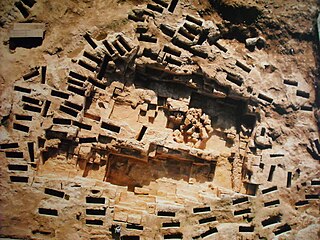
The necropolis of Tuvixeddu is a Punic necropolis, the largest in the Mediterranean. It is located in a hill inside the city of Cagliari, Sardinia called Tuvixeddu.
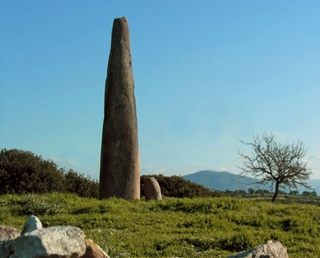
The Pre-Nuragic period refers to the prehistory of Sardinia from the Paleolithic until the middle Bronze Age, when the Nuragic civilization flourished on the island.
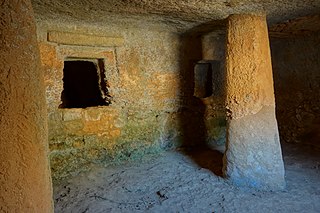
The necropolis of Anghelu Ruju is a pre-Nuragic archaeological site located north of the city of Alghero, Province of Sassari, Sardinia. It is the largest necropolis of pre-Nuragic Sardinia.
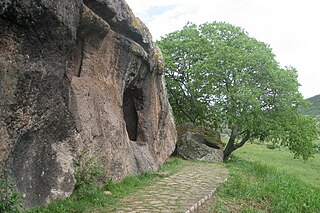
The necropolis of Sant'Andrea Priu is an archaeological site located on the south side of the fertile plain of Saint Lucia, in the municipality of Bonorva, Sardinia. The complex, one of the most important of the island, is composed of twenty domus de janas; one of them with its eighteen rooms appears to be one of the largest hypogean tombs of the Mediterranean basin.

The necropolis of Su Crucifissu Mannu is an archaeological site located in the municipality of Porto Torres, Sardinia.

The nuraghe Is Paras is an archeological site of Isili, a town in the historical region of Sarcidano, province of South Sardinia.

The Beaker culture in Sardinia appeared circa 2100 BC during the last phase of the Chalcolithic period. It initially coexisted with and then replaced the previous Monte Claro culture in Sardinia, developing until the ancient Bronze Age circa 1900–1800 BC. Then, the Beaker culture mixed with the related Bonnanaro culture, considered the first stage of the Nuragic civilization.

The necropolis of Is Loccis-Santus is an archaeological site located in the municipality of San Giovanni Suergiu, Sardinia.
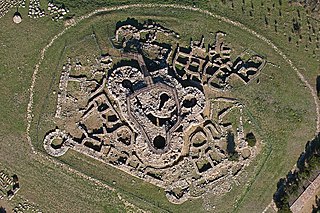
The nuraghe Genna Maria is an archaeological site in the comune of Villanovaforru, province of South Sardinia.

The Menhir Museum, or Civic Archaeological Museum of the Menhir Statues, located in the Aymerich Palace in the village of Laconi, is a unique museum of its kind for its rich collection of steles found in the Laconi area, with the first discovery in 1969.
Architecture of Sardinia has developed since 4000 B.C., presenting characteristic aspects in certain historical periods, especially in the Nuragic age.



















